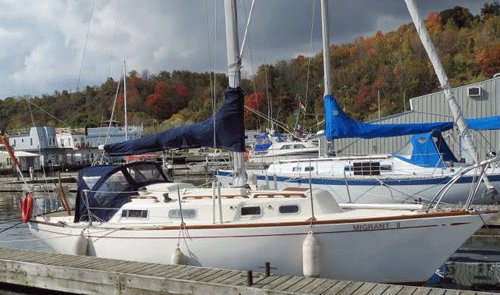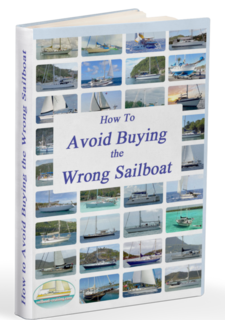- Home
- Cruiser Yachts under 30'
- Northern 29
The Northern 29 Sailboat
Specs & Key Performance Indicators
The Northern 29, a masthead sloop, was designed by Sparkman & Stephens and built in Canada by Northern Yacht Ltd.
 A Northern 29 sloop
A Northern 29 sloopPublished Specification for the Northern 29
Underwater Configuration: Fin & Skeg
Hull Material: GRP (Fiberglass)
Length Overall: 29' 0" / 8.8m
Waterline Length: 21' 3" / 6.5m
Beam: 9' 0" / 2.7m
Draft: 4' 6" / 1.4m
Rig Type: Masthead Sloop
Displacement: 7,250lb / 3,289kg
Designer: Sparkman & Stephens
Builder: Northern Yacht Ltd (Canada)
Year First Built: 1972
Published Design Ratios for the Northern 29
Sail Area/Displacement Ratio: 16.5
Ballast/Displacement Ratio: 51.8
Displacement/Length Ratio: 337
Comfort Ratio: 25.5
Capsize Screening Formula: 1.9
read more about these all-revealing numbers...
Summary Analysis of the Design Ratios for the Northern 29
A Sail Area/Displacement Ratio of 16.5 suggests that the Northern 29 will approach her maximum hull speed readily and satisfy the sailing performance expectations of most cruising sailors.
A Ballast/Displacement Ratio of 51.8 means that she'll stand up well to her canvas in a blow, helping her to power through the waves.
A Displacement/Length Ratio of 337, tells us she's clearly a heavy displacement cruising boat. You can load her down with all your cruising gear and equipment and it will hardly affect her waterline.
Ted Brewer's Comfort Ratio of 25.5 suggests that crew comfort in a seaway is similar to what you would associate with the motion of a coastal cruiser with moderate stability, which is not encouraging news for anyone prone to seasickness.
Her Capsize Screening Formula (CSF) of 1.9 tells us that she would be a safer choice of sailboat for offshore sailing than one with a CSF of more than 2.0.
The Northern 29: A Classic Coastal Cruiser
The Northern 29 is a monohull sailboat with a fin keel and a skeg-hung rudder. It has a fiberglass hull and deck, with a lead ballast. The mast is keel-stepped and the rig is simple and efficient, with a single spreader and a backstay. The sail area is 35.9 m², which gives the boat a sail area/displacement ratio of 16.5. This means that the boat is moderately powered and can handle a variety of wind conditions.
The Northern 29 has a displacement of 3,289 kg and a ballast/displacement ratio of 51.7%. This means that the boat is heavy and stiff, with a good righting moment if heeled or capsized. The boat has a comfort ratio of 25.3, which indicates that it is suitable for coastal cruising and can handle moderate seas. The boat has a capsize screening of 1.9, which means that it has a low risk of capsizing in bad weather.
The Northern 29 has a waterline length of 6.5 m and a beam of 2.7 m. It has a draft of 1.4 m, which allows it to access shallow waters and anchorages. The boat has an air draft of 12.8 m, which means that it can pass under most bridges and power lines.
The Northern 29 has an auxiliary engine, which is usually a Universal Atomic 4 gas engine with 30 HP. The fuel capacity is 38 l, which gives the boat a limited range under power. The water capacity is 57 litres, which also limits the duration of cruising without refilling.
Accommodation
The Northern 29 has a spacious and cozy interior, with enough room for four to six people to sleep comfortably. The layout consists of:
- A V-berth in the forward cabin, with storage lockers and shelves;
- A head compartment to port, with a marine toilet and a sink;
- A hanging locker to starboard, opposite the head;
- A main saloon with two settees that can convert into berths, and a folding table in the center;
- A galley to port, with a two-burner stove, an icebox and a sink;
- A navigation station to starboard, with a chart table and an electrical panel;
- A quarter berth aft of the navigation station, which can also be used as storage.
The interior has plenty of natural light and ventilation, thanks to the large windows and hatches. The headroom is about 1.8 m, which is adequate for most people. The cabinetry and trim are made of teak wood, which adds warmth and elegance to the atmosphere.
Hull and Deck
The hull and deck of the Northern 29 are made of fiberglass, with balsa core in some areas for stiffness and insulation. The hull shape is round-bottomed, with a moderate freeboard and overhangs. The deck is flat and wide, with non-skid surface and teak toe rails. The cockpit is aft, with a tiller steering system and an engine control panel. The cockpit seats are long and comfortable, with storage lockers underneath.
The deck hardware is simple and functional, with stainless steel fittings and cleats. The bow has an anchor locker and a bow roller for easy anchoring. The stern has a boarding ladder for easy access to the water.
Mast and Rigging
The mast and rigging of the Northern 29 are designed for performance and ease of handling. The mast is made of aluminum alloy, with a single spreader and a backstay. The mast is keel-stepped, which adds strength and stability to the rig. The boom is also made of aluminum alloy, with an internal reefing system.
The sail plan consists of a mainsail and a genoa, which are controlled by winches and tracks on the deck. The sails are made of dacron, with reinforced corners and battens. The boat also has a spinnaker, which can be flown from a spinnaker pole on the mast.
The rigging is made of stainless steel wire, with swaged terminals and turnbuckles. The rigging is simple and efficient, with a forestay, a backstay, two upper shrouds, two lower shrouds and two intermediate shrouds. The rigging is adjustable, with a backstay tensioner and a babystay.
Keel and Rudder
The keel and rudder of the Northern 29 are designed for stability and maneuverability. The keel is a fin keel, with a lead ballast. The keel has a moderate aspect ratio, which means that it is not too deep or too shallow. The keel provides lift and reduces leeway when sailing upwind.
The rudder is a skeg-hung rudder, which means that it is attached to a skeg that extends from the hull. The rudder has a balanced shape, which means that it has some area forward of the rudder post. The rudder provides good steering control and reduces weather helm when sailing on the wind.
This article was written with the assistance of Gemini, a large language model developed by Google. Gemini was used to gather information, summarize research findings, and provide suggestions for the content and structure of the article.
Recent Articles
-
Modern Boat Electronics and the Latest Marine Instruments
Dec 20, 25 05:27 PM
Should sailboat instruments be linked to the latest boat electronics as a fully integrated system, or is it best to leave them as independent units? -
Hans Christian 43: Classic Bluewater Cruiser & Liveaboard Sailboat
Dec 10, 25 04:37 AM
Explore the Hans Christian 43: a legendary heavy-displacement, long-keel sailboat. Read our in-depth review of its specs, design ratios, and suitability for offshore cruising and living aboard. -
Planning Your Sailboat Liveaboard Lifestyle: An Ocean Sailor's Guide
Dec 06, 25 05:18 AM
Seasoned sailors share their methodical risk analysis for planning a secure Sailboat Liveaboard Lifestyle, covering financial, property, and relationship risks.













